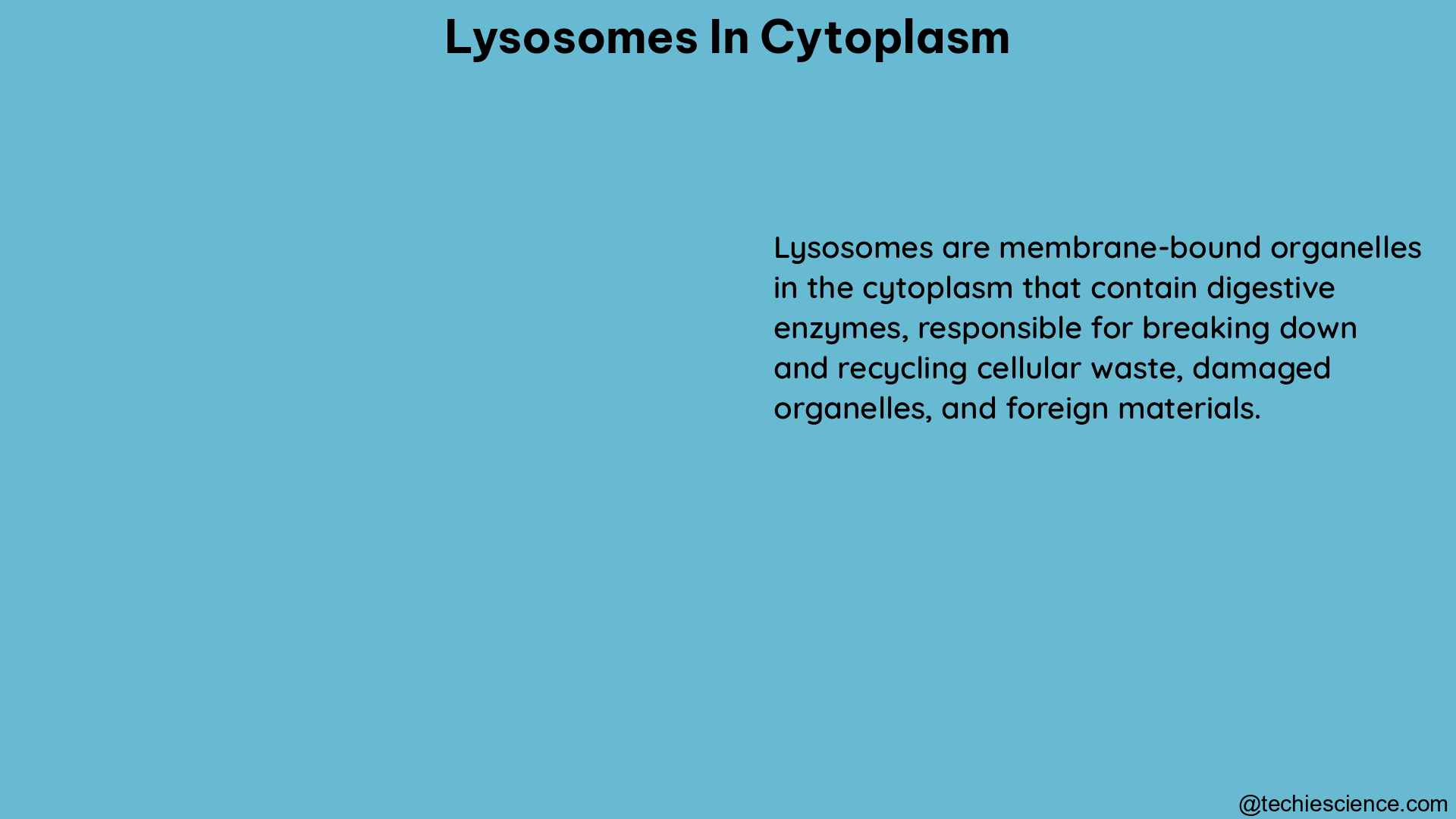Lysosomes are specialized organelles found within the cytoplasm of eukaryotic cells, playing a crucial role in cellular homeostasis, degradation, and signaling. These membrane-bound vesicles contain a variety of hydrolytic enzymes that can break down a wide range of biomolecules, including proteins, lipids, and nucleic acids. Understanding the morphology, positioning, motility, and function of lysosomes is essential for unraveling their complex roles in cellular processes. In this comprehensive guide, we will delve into the various methods used to analyze these key aspects of lysosomes in the cytoplasm.
Morphology and Positioning of Lysosomes
Lysosomes exhibit a diverse range of sizes, shapes, and numbers, depending on the cell type and physiological conditions. To analyze their morphology, researchers employ various electron microscopy techniques, such as:
-
Transmission Electron Microscopy (TEM): TEM provides high-resolution images of the internal structure of lysosomes, allowing for the measurement of their size, shape, and distribution within the cytoplasm. This technique has been used to study the ultrastructural changes in lysosomes during cellular processes, such as autophagy and lysosomal storage disorders.
-
Scanning Electron Microscopy (SEM): SEM is particularly useful for visualizing the surface topography of lysosomes, providing insights into their overall morphology and interactions with other cellular components.
-
Immunoelectron Microscopy (IEM): IEM combines the high-resolution imaging of electron microscopy with the specificity of antibody labeling, enabling the identification and localization of specific lysosomal proteins within the cell.
For instance, a study using TEM and IEM revealed that in Niemann-Pick type C (NPC) disease, a lysosomal storage disorder, lysosomes exhibit an increased number and aggregation within the cytoplasm, compared to healthy cells. This morphological change is a hallmark of the disease and can be quantified using lysosomal morphometric assays.
In addition to electron microscopy, fluorescence microscopy techniques, such as confocal microscopy and high-content imaging, can be used to analyze lysosome morphology and positioning. By labeling lysosomes with fluorescent probes or antibodies, researchers can measure the size, number, and distribution of lysosomal puncta within the cytoplasm, providing valuable insights into their organization and dynamics.
Lysosome Motility

Lysosomes are not static organelles; they exhibit dynamic movement within the cytoplasm, which is crucial for their function and positioning. To study lysosome motility, researchers employ live-cell imaging techniques, such as:
-
Total Internal Reflection Fluorescence (TIRF) Microscopy: TIRF microscopy allows for the visualization of fluorescently labeled lysosomes near the cell surface, enabling the tracking of their movement and the analysis of their velocity and directionality.
-
Spinning Disk Confocal Microscopy: This technique provides high-speed, high-resolution imaging of lysosomes within the cytoplasm, allowing for the quantification of their movement patterns and the identification of factors that regulate their motility.
-
High-Speed Confocal Microscopy: By capturing images at a high frame rate, high-speed confocal microscopy enables the detailed analysis of lysosome movement, including their trajectories, velocities, and interactions with other cellular structures.
Studies using these live-cell imaging techniques have revealed that lysosomes exhibit both directed and random motion within the cytoplasm. The directed motion of lysosomes is often associated with their transport along microtubules, mediated by motor proteins such as kinesins and dyneins. This directed movement is more pronounced in regions closer to the microtubule-organizing center (MTOC), suggesting that the microtubule network and associated motor proteins play a crucial role in regulating lysosome positioning and distribution within the cell.
Functional Analysis of Lysosomes
Lysosomes are not merely degradative organelles; they also play important roles in cellular signaling, membrane repair, and cell death. To analyze the function of lysosomes, researchers employ a variety of methods, including:
-
Enzymatic Activity Assays: These assays measure the activity of lysosomal hydrolases, such as cathepsins, in the cytosol or lysosomal fractions. By quantifying the enzymatic activity, researchers can gain insights into the functional state of lysosomes and their involvement in cellular processes.
-
Fluorescence-based Assays: Techniques like the DQ-BSA assay use fluorogenic substrates to visualize and quantify lysosomal proteolytic activity in live cells. These assays provide a direct readout of lysosomal function and can be used to monitor changes in lysosomal activity under different experimental conditions.
-
Immunocytochemistry: This method involves the use of specific antibodies to detect the presence and localization of lysosomal markers, such as LAMP-1 and LAMP-2, as well as lysosomal hydrolases. By combining immunocytochemistry with microscopy, researchers can study the distribution and abundance of lysosomal components within the cell.
One example of the functional analysis of lysosomes is the study of lysosomal membrane permeabilization (LMP), a key event in lysosomal cell death. Researchers have used enzymatic activity assays and fluorescence microscopy to demonstrate that LMP leads to the release of lysosomal hydrolases, such as cathepsins, into the cytosol, triggering apoptotic or necrotic cell death pathways. By quantifying the activity of these hydrolases in the cytosol, researchers can assess the degree of LMP and its implications for cellular homeostasis and disease.
In conclusion, the comprehensive analysis of lysosome morphology, positioning, motility, and function is essential for understanding their diverse roles in cellular processes. The methods discussed in this guide, including electron microscopy, live-cell imaging, and functional assays, provide a powerful toolkit for researchers to unravel the complex biology of lysosomes in the cytoplasm.
References:
- Barral Duarte C, Staiano Leopoldo, Guimas Almeida Cláudia, Cutler Dan F, Eden Emily R, Futter Clare E, et al. Current methods to analyze lysosome morphology, positioning, motility and function. Traffic. 2022;23(5):302-320. doi:10.1111/tra.12839
- Nylandsted J, Foghsgaard K, Jäättelä M. Methods for the functional quantification of lysosomal membrane permeabilization: a hallmark of lysosomal cell death. Nat Protoc. 2021;16(9):3377-3396. doi:10.1038/s41596-021-00551-w
- Appelqvist A-L, Wäster P, Saftig P, Winckler B. Methods for the quantification of lysosomal membrane permeabilization. Methods Mol Biol. 2013;980:119-130. doi:10.1007/978-1-62703-561-4_9
- Koga H, Kobayashi T, Kuroda S, et al. Lysosomal membrane permeabilization and cathepsin release are involved in the initiation of apoptosis in response to ceramide. J Biol Chem. 2005;280(47):39007-39014. doi:10.1074/jbc.M507427200
- Saftig P, Klumperman J. Lysosomes: from degradation to signaling. Nat Rev Mol Cell Biol. 2019;20(1):43-57. doi:10.1038/s41580-018-0095-z

Hello, I am Bhairavi Rathod, I have completed my Master’s in Biotechnology and qualified ICAR NET 2021 in Agricultural Biotechnology. My area of specialization is Integrated Biotechnology. I have the experience to teach and write very complex things in a simple way for learners.